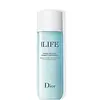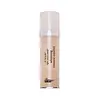What's inside
What's inside
 Key Ingredients
Key Ingredients

 Benefits
Benefits

 Concerns
Concerns

 Ingredients Side-by-side
Ingredients Side-by-side

Water
Skin ConditioningPropanediol
SolventGlycerin
HumectantPentylene Glycol
Skin ConditioningPropylene Glycol
HumectantMicrocrystalline Cellulose
AbsorbentPhenoxyethanol
PreservativePEG-32
HumectantSodium Citrate
BufferingCaprylic/Capric Triglyceride
MaskingAscorbyl Glucoside
AntioxidantPEG-12 Dimethicone
Skin ConditioningPEG-60 Hydrogenated Castor Oil
EmulsifyingCellulose Gum
Emulsion StabilisingParfum
MaskingMalva Sylvestris Extract
AstringentButylene Glycol
HumectantPoloxamer 407
EmulsifyingCitric Acid
BufferingSodium Dilauramidoglutamide Lysine
HumectantTocopherol
AntioxidantHydrogenated Lecithin
EmulsifyingHyaluronic Acid
HumectantHaberlea Rhodopensis Leaf Extract
Skin ConditioningBenzyl Alcohol
PerfumingPaeonia Suffruticosa Root Extract
Skin ProtectingBHT
AntioxidantWater, Propanediol, Glycerin, Pentylene Glycol, Propylene Glycol, Microcrystalline Cellulose, Phenoxyethanol, PEG-32, Sodium Citrate, Caprylic/Capric Triglyceride, Ascorbyl Glucoside, PEG-12 Dimethicone, PEG-60 Hydrogenated Castor Oil, Cellulose Gum, Parfum, Malva Sylvestris Extract, Butylene Glycol, Poloxamer 407, Citric Acid, Sodium Dilauramidoglutamide Lysine, Tocopherol, Hydrogenated Lecithin, Hyaluronic Acid, Haberlea Rhodopensis Leaf Extract, Benzyl Alcohol, Paeonia Suffruticosa Root Extract, BHT
Water
Skin ConditioningDipropylene Glycol
HumectantPentylene Glycol
Skin ConditioningGlycerin
HumectantButylene Glycol
HumectantBis-PEG-18 Methyl Ether Dimethyl Silane
EmollientArginine
MaskingJojoba Wax PEG-120 Esters
Dimethicone PEG-8 Meadowfoamate
EmollientPPG-26-Buteth-26
Skin ConditioningPEG-40 Hydrogenated Castor Oil
EmulsifyingCaprylyl Glycol
EmollientPhenoxyethanol
PreservativePEG-32
HumectantBiosaccharide Gum-1
HumectantAstaxanthin
Skin ConditioningSodium Hyaluronate
HumectantDisodium EDTA
Carbomer
Emulsion StabilisingLactobacillus/Punica Granatum Fruit Ferment Extract
Skin ConditioningLonicera Caprifolium Flower Extract
PerfumingAscorbyl Glucoside
AntioxidantBeta-Glucan
Skin ConditioningDipotassium Glycyrrhizate
HumectantGlycine Soja Oil
EmollientPvm/Ma Copolymer
Emulsion StabilisingPolyglyceryl-10 Oleate
Skin ConditioningAcrylates/C10-30 Alkyl Acrylate Crosspolymer
Emulsion StabilisingLavandula Angustifolia Oil
MaskingTocopherol
AntioxidantAlteromonas Ferment Extract
Skin ConditioningLysolecithin
EmulsifyingZiziphus Jujuba Fruit Extract
Skin ConditioningHaematococcus Pluvialis Extract
AntioxidantPolyglyceryl-10 Stearate
Skin ConditioningCyclopentasiloxane
EmollientPEG-11 Methyl Ether Dimethicone
EmulsifyingSodium Polyacrylate
AbsorbentCaprylic/Capric Triglyceride
MaskingGlycyrrhiza Glabra Root Extract
BleachingDaucus Carota Sativa Root Extract
Skin ConditioningBeta-Carotene
Skin ConditioningCamellia Sinensis Leaf Extract
AntimicrobialHalidrys Siliquosa Extract
Skin ConditioningWater, Dipropylene Glycol, Pentylene Glycol, Glycerin, Butylene Glycol, Bis-PEG-18 Methyl Ether Dimethyl Silane, Arginine, Jojoba Wax PEG-120 Esters, Dimethicone PEG-8 Meadowfoamate, PPG-26-Buteth-26, PEG-40 Hydrogenated Castor Oil, Caprylyl Glycol, Phenoxyethanol, PEG-32, Biosaccharide Gum-1, Astaxanthin, Sodium Hyaluronate, Disodium EDTA, Carbomer, Lactobacillus/Punica Granatum Fruit Ferment Extract, Lonicera Caprifolium Flower Extract, Ascorbyl Glucoside, Beta-Glucan, Dipotassium Glycyrrhizate, Glycine Soja Oil, Pvm/Ma Copolymer, Polyglyceryl-10 Oleate, Acrylates/C10-30 Alkyl Acrylate Crosspolymer, Lavandula Angustifolia Oil, Tocopherol, Alteromonas Ferment Extract, Lysolecithin, Ziziphus Jujuba Fruit Extract, Haematococcus Pluvialis Extract, Polyglyceryl-10 Stearate, Cyclopentasiloxane, PEG-11 Methyl Ether Dimethicone, Sodium Polyacrylate, Caprylic/Capric Triglyceride, Glycyrrhiza Glabra Root Extract, Daucus Carota Sativa Root Extract, Beta-Carotene, Camellia Sinensis Leaf Extract, Halidrys Siliquosa Extract
Ingredients Explained
These ingredients are found in both products.
Ingredients higher up in an ingredient list are typically present in a larger amount.
Ascorbyl Glucoside is a stable form of Vitamin C. It is created by combining glucose from starch.
When applied to skin, Ascorbyl Glucoside turns into Ascorbic Acid.
Ascorbyl Glucoside is an antioxidant. Antioxidants help fight free-radicals, or molecules that may damage skin cells.
It can help to reduce redness, improve skin texture, reduce the effects of aging, reduce the visibility of dark spots, and brighten skin.
Read more about other types of Vitamin C:
Learn more about Ascorbyl GlucosideButylene Glycol (or BG) is used within cosmetic products for a few different reasons:
Overall, Butylene Glycol is a safe and well-rounded ingredient that works well with other ingredients.
Though this ingredient works well with most skin types, some people with sensitive skin may experience a reaction such as allergic rashes, closed comedones, or itchiness.
Learn more about Butylene GlycolThis ingredient is an emollient, solvent, and texture enhancer. It is considered a skin-softener by helping the skin prevent moisture loss.
It helps thicken a product's formula and makes it easier to spread by dissolving clumping compounds.
Caprylic Triglyceride is made by combining glycerin with coconut oil, forming a clear liquid.
While there is an assumption Caprylic Triglyceride can clog pores due to it being derived from coconut oil, there is no research supporting this.
Learn more about Caprylic/Capric TriglycerideGlycerin is already naturally found in your skin. It helps moisturize and protect your skin.
A study from 2016 found glycerin to be more effective as a humectant than AHAs and hyaluronic acid.
As a humectant, it helps the skin stay hydrated by pulling moisture to your skin. The low molecular weight of glycerin allows it to pull moisture into the deeper layers of your skin.
Hydrated skin improves your skin barrier; Your skin barrier helps protect against irritants and bacteria.
Glycerin has also been found to have antimicrobial and antiviral properties. Due to these properties, glycerin is often used in wound and burn treatments.
In cosmetics, glycerin is usually derived from plants such as soybean or palm. However, it can also be sourced from animals, such as tallow or animal fat.
This ingredient is organic, colorless, odorless, and non-toxic.
Glycerin is the name for this ingredient in American English. British English uses Glycerol/Glycerine.
Learn more about GlycerinPEG-32 is a synthetic and water-soluble polymer with 32 repeating units. It has humectant, solvent, and emulsifying properties.
As a solvent and emulsifier, it helps dissolve and blend ingredients. It is also able to attract water as a humectant to help hydrate skin. According to a manufacturer, this ingredient is non-greasy, gentle, and mildly scented.
Japanese manufacturers will sometimes call this ingredient PEG 1540.
Learn more about PEG-32Pentylene glycol is typically used within a product to thicken it. It also adds a smooth, soft, and moisturizing feel to the product. It is naturally found in plants such as sugar beets.
The hydrophilic trait of Pentylene Glycol makes it a humectant. As a humectant, Pentylene Glycol helps draw moisture from the air to your skin. This can help keep your skin hydrated.
This property also makes Pentylene Glycol a great texture enhancer. It can also help thicken or stabilize a product.
Pentylene Glycol also acts as a mild preservative and helps to keep a product microbe-free.
Some people may experience mild eye and skin irritation from Pentylene Glycol. We always recommend speaking with a professional about using this ingredient in your routine.
Pentylene Glycol has a low molecular weight and is part of the 1,2-glycol family.
Learn more about Pentylene GlycolPhenoxyethanol is a preservative that has germicide, antimicrobial, and aromatic properties. Studies show that phenoxyethanol can prevent microbial growth. By itself, it has a scent that is similar to that of a rose.
It's often used in formulations along with Caprylyl Glycol to preserve the shelf life of products.
Tocopherol (also known as Vitamin E) is a common antioxidant used to help protect the skin from free-radicals and strengthen the skin barrier. It's also fat soluble - this means our skin is great at absorbing it.
Vitamin E also helps keep your natural skin lipids healthy. Your lipid skin barrier naturally consists of lipids, ceramides, and fatty acids. Vitamin E offers extra protection for your skin’s lipid barrier, keeping your skin healthy and nourished.
Another benefit is a bit of UV protection. Vitamin E helps reduce the damage caused by UVB rays. (It should not replace your sunscreen). Combining it with Vitamin C can decrease sunburned cells and hyperpigmentation after UV exposure.
You might have noticed Vitamin E + C often paired together. This is because it is great at stabilizing Vitamin C. Using the two together helps increase the effectiveness of both ingredients.
There are often claims that Vitamin E can reduce/prevent scarring, but these claims haven't been confirmed by scientific research.
Learn more about TocopherolWater. It's the most common cosmetic ingredient of all. You'll usually see it at the top of ingredient lists, meaning that it makes up the largest part of the product.
So why is it so popular? Water most often acts as a solvent - this means that it helps dissolve other ingredients into the formulation.
You'll also recognize water as that liquid we all need to stay alive. If you see this, drink a glass of water. Stay hydrated!
Learn more about Water